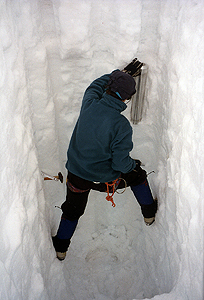Jan 29 2009
Glaciers around the globe continue to melt at high rates. Tentative figures for the year 2007, of the World Glacier Monitoring Service at the University of Zurich, Switzerland, indicate a further loss of average ice thickness of roughly 0.67 meter water equivalent (m w.e.). Some glaciers in the European Alps lost up to 2.5 m w.e.
 Density measurements in a snow pit in a glacier accumulation zone. Photo by M. Hoelzle
Density measurements in a snow pit in a glacier accumulation zone. Photo by M. Hoelzle
The new still tentative data of more than 80 glaciers confirm the global trend of fast ice loss since 1980. Glaciers with long-term observation series (30 glaciers in 9 mountain ranges) have experienced a reduction in total thickness of more than 11 m w.e. until 2007. The average annual ice loss during 1980-1999 was roughly 0.3 m w.e. per year. Since 2000, this rate has increased to about 0.7 m w.e. per year.
Michael Zemp, glaciologist and research associate of the WGMS, said: "The average ice loss in 2007 was not as extreme as in 2006, but there were large differences between mountain ranges. Glaciers in the European Alps lost up to 2.5 meters water equivalent of ice, whereas maritime glaciers in Scandinavia were able to gain more than a meter in thickness. However, 2007 is now the sixth year of this century in which the average ice loss of the reference glaciers has exceeded half a meter. This has resulted in a more than doubling of the melt rates of the 1980s and 90s."
For the observation period 2007, dramatic ice losses were reported from glaciers in the European Alps, such as of the Hintereisferner (-1.8 m w.e.) or the Sonnblickkess (-2.2 m w.e.) in Austria, the Sarennes (-2.5 m w.e.) in France, the Caresèr (-2.8 m w.e.) in Italy, or of the Silvretta (-1.3 m w.e.) and Gries (-1.7 m w.e.) in Switzerland. In Norway, many maritime glaciers were able to gain mass, e.g. the Nigardsbreen (+1.0 m w.e.) or the Ålfotbreen (+1.3 m w.e.), although the glaciers further inland have continued to shrink, e.g. the Hellstugubreen or the Gråsubreen (both with -0.7 m w.e.).
All mass balance programmes in South American reported negative values ranging from -0.1 m w.e. at the Echaurren Norte in Chile to -2.2 m w.e. at the Ritacuba Negro in Columbia. In North America some positive values were reported from the North Cascade Mountains and the Juneau Ice Field together with a continued ice loss from the glaciers in the Kenai Mountains and the Alaskan Range as well as from Canada’s Coast Mountains and High Arctic.